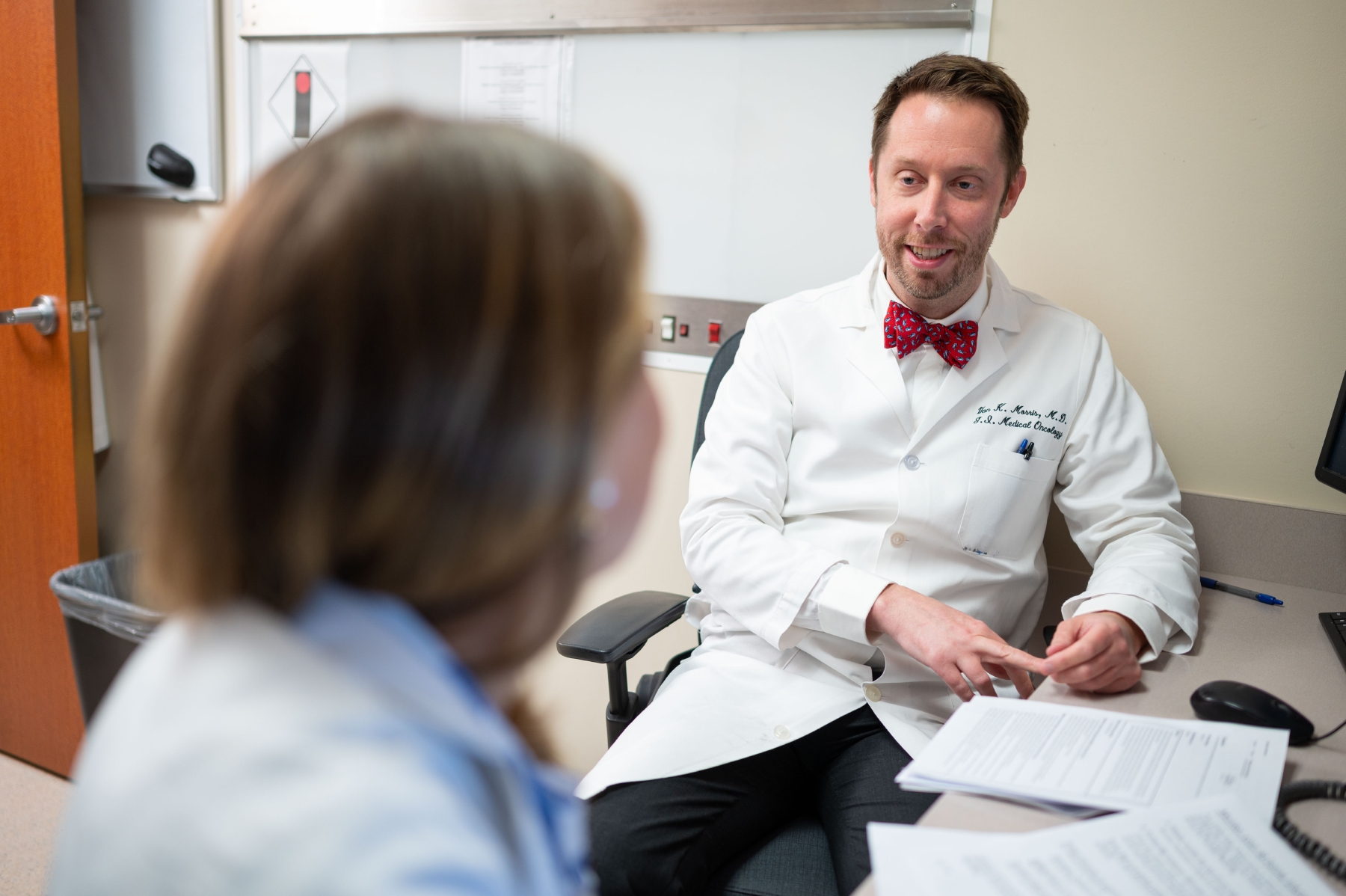- Diseases
- Acoustic Neuroma (14)
- Adrenal Gland Tumor (24)
- Anal Cancer (66)
- Anemia (2)
- Appendix Cancer (16)
- Bile Duct Cancer (28)
- Bladder Cancer (68)
- Brain Metastases (28)
- Brain Tumor (228)
- Breast Cancer (710)
- Breast Implant-Associated Anaplastic Large Cell Lymphoma (2)
- Cancer of Unknown Primary (4)
- Carcinoid Tumor (8)
- Cervical Cancer (154)
- Colon Cancer (164)
- Colorectal Cancer (110)
- Endocrine Tumor (4)
- Esophageal Cancer (42)
- Eye Cancer (36)
- Fallopian Tube Cancer (6)
- Germ Cell Tumor (4)
- Gestational Trophoblastic Disease (2)
- Head and Neck Cancer (4)
- Kidney Cancer (124)
- Leukemia (344)
- Liver Cancer (50)
- Lung Cancer (288)
- Lymphoma (284)
- Mesothelioma (14)
- Metastasis (30)
- Multiple Myeloma (98)
- Myelodysplastic Syndrome (60)
- Myeloproliferative Neoplasm (4)
- Neuroendocrine Tumors (16)
- Oral Cancer (98)
- Ovarian Cancer (172)
- Pancreatic Cancer (166)
- Parathyroid Disease (2)
- Penile Cancer (14)
- Pituitary Tumor (6)
- Prostate Cancer (144)
- Rectal Cancer (58)
- Renal Medullary Carcinoma (6)
- Salivary Gland Cancer (14)
- Sarcoma (234)
- Skin Cancer (294)
- Skull Base Tumors (54)
- Spinal Tumor (12)
- Stomach Cancer (60)
- Testicular Cancer (28)
- Throat Cancer (90)
- Thymoma (6)
- Thyroid Cancer (98)
- Tonsil Cancer (30)
- Uterine Cancer (78)
- Vaginal Cancer (14)
- Vulvar Cancer (18)
- Cancer Topic
- Adolescent and Young Adult Cancer Issues (20)
- Advance Care Planning (10)
- Biostatistics (2)
- Blood Donation (18)
- Bone Health (8)
- COVID-19 (362)
- Cancer Recurrence (120)
- Childhood Cancer Issues (120)
- Clinical Trials (620)
- Complementary Integrative Medicine (22)
- Cytogenetics (2)
- DNA Methylation (4)
- Diagnosis (224)
- Epigenetics (6)
- Fertility (62)
- Follow-up Guidelines (2)
- Health Disparities (14)
- Hereditary Cancer Syndromes (122)
- Immunology (18)
- Li-Fraumeni Syndrome (8)
- Mental Health (116)
- Molecular Diagnostics (8)
- Pain Management (64)
- Palliative Care (8)
- Pathology (10)
- Physical Therapy (18)
- Pregnancy (18)
- Prevention (878)
- Research (384)
- Second Opinion (74)
- Sexuality (16)
- Side Effects (596)
- Sleep Disorders (10)
- Stem Cell Transplantation Cellular Therapy (216)
- Support (404)
- Survivorship (324)
- Symptoms (182)
- Treatment (1762)
Ovarian cancer diagnosis and treatment: What’s new
BY Devon Carter
4 minute read | Published February 06, 2018
Medically Reviewed | Last reviewed by an MD Anderson Cancer Center medical professional on February 06, 2018
Because its symptoms are often vague, ovarian cancer can be hard to diagnose. And a definitive diagnosis requires a biopsy, which is best done at the time of surgery. But MD Anderson’s Ovarian Cancer Moon Shot™ is focused on finding new ways to detect the disease earlier, when it’s easier to treat.
We spoke with Anil Sood, M.D., co-leader of the Ovarian Cancer Moon Shot, to learn about the latest advances in ovarian cancer diagnosis and treatment. Here’s what he shared.
Who’s at risk for ovarian cancer?
Trends suggest that women around age 59, who’ve never been pregnant and who have an inflammatory disorder like endometriosis are more likely to develop ovarian cancer. It was once thought that using talc-based products, like baby powder, increased the risk, but studies haven’t shown a direct cause-and-effect relationship.
Also, women with a mutation in the BRCA1 or BRCA2 genes are at higher risk. For these women, ovarian cancer is hereditary, so it’s important to undergo genetic testing if your mom, grandmother or aunts have been diagnosed with ovarian or breast cancer before age 40. Women of Ashkenazi Jewish ancestry (Jewish people who originated from Central or Eastern Europe) are more likely to have a BRCA gene mutation, too.
Is there anything that lowers a woman’s risk for ovarian cancer?
We’re studying ovarian cancer prevention more, but we’ve seen that having a pregnancy, taking the birth control pill and undergoing a tubal ligation (commonly referred to as having your tubes tied) all lower the risk. Patients should talk with their doctor if they’re concerned about their risk.
What are common symptoms of ovarian cancer?
Among the most common ovarian cancer symptoms is bloating — so, clothes not fitting right. But patients can also experience pelvic pain or pressure, as well as nausea. These symptoms are also common in other conditions that aren’t cancer, but the key distinction is that ovarian cancer symptoms continue to persist for a month or longer.
If you’re feeling continued discomfort in the pelvic area, seek out a gynecologic oncologist. Discussing your symptoms with an expert will ensure you get the most appropriate tests to figure out what’s going on. Those tests can include a pelvic exam, an ultrasound and blood tests.
How is ovarian cancer diagnosed?
Ovarian cancer is diagnosed with a tissue sample that’s taken at the same time the tumor is removed surgically, either laparoscopically or with an incision. The type of surgery depends on the size of the mass and if it has spread.
Not all tumors are cancerous though. In some cases, when the patient is in her reproductive years and has a mass that doesn’t show the signs of cancer — so, no solid areas or blood flow — we may simply monitor it. It’s not uncommon for ovarian cysts to be benign and go away naturally. When the cysts begin to grow and/or develop connecting or solid areas, that’s when we become more concerned.
Is there a test that can diagnose ovarian cancer early?
There isn’t an ovarian cancer screening test now, but MD Anderson is trying to change that. There has been encouraging data with protein-based tests, such as CA-125, but results weren’t strong enough to roll this out to the larger patient community. So we’re exploring other approaches, such as auto-antibodies, exosomes and nucleic acids within the blood, and even new ways of doing imaging to find small abnormalities sooner.
What promising new ovarian cancer treatments are on the horizon at MD Anderson?
Among the more exciting areas we’re studying through clinical trials are drugs that target the blood supply to the cancer and pathways that are frequently altered in ovarian cancer. We’re also building on the success of PARP inhibitors by combining them with other drugs. We’re going after nanoparticle-based strategies as well. Unfortunately, we haven’t found that immunotherapy treatments work as well for ovarian cancer, but that doesn’t mean we give up. We’re working to improve the effectiveness of these therapies.
How has the Ovarian Cancer Moon Shot advanced treatment?
One of the Ovarian Cancer Moon Shot’s successes has been in personalizing surgery to ensure patients receive the best treatment for their specific case. Historically, every patient would undergo surgery with a large incision, but we now examine a patient laparoscopically first. Then, based on the findings of the size and spread of the cancer, we’ll proceed with the full surgery if we think we can remove all of the disease in one procedure. If the cancer is more advanced, we start with chemotherapy before doing the full surgery in the hopes that the tumors have shrunk. With our new approach, we’re able to remove all visible disease in patients who receive the full surgery upfront about 88% of the time. In patients who receive chemotherapy, we’re able to remove all visible disease in around 75% of the time.
What’s your advice for newly diagnosed ovarian cancer patients?
It’s important to see an experienced gynecologist oncologist, rather than your regular gynecologist. Getting the right treatment up front increases your chances of success in managing ovarian cancer. And, if you need chemotherapy, it’s important the right drugs be given for the subtype of ovarian cancer you have. Lastly, since ovarian cancer is often genetic, I always recommend undergoing genetic counseling and testing after a diagnosis. This can provide powerful knowledge that can help protect you from other cancers and protect your family members as well.
Request an appointment at MD Anderson online or by calling 1-844-829-9300
Related Cancerwise Stories

With our new approach, we’re able to remove all visible disease in patients who receive the full surgery upfront about 88% of the time.
Anil Sood, M.D.
Physician





